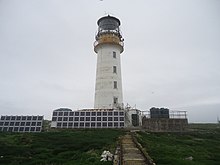Sule Skerry
59°05′N 4°25′W / 59.08°N 4.41°W / 59.08; -4.41



Sule Skerry is a remote skerry in the North Atlantic off the north coast of Scotland.
Geography
Sule Skerry lies 60 kilometres (32 nautical miles) west of the Orkney Mainland at grid reference HX621244. Sule Skerry's sole neighbour, Sule Stack, lies 10 km (5+1⁄2 nmi) to the southwest; the remote islands of Rona and Sula Sgeir lie approximately 80 km (45 nmi) further west. Sule Skerry and Sule Stack are both a part of the Orkney Islands council area.
Sule Skerry is 16 hectares (40 acres) in area and about 800 m (1⁄2 mi) long.[6] It reaches a height of 12 metres (40 feet).[7] It is formed of Lewisian gneiss.[8]
Biology
Sule Skerry together with Sule Stack are listed as a Special Protection Area as they are home during the breeding season to thousands of puffins and gannets and smaller numbers of the rarer Leach's storm petrel and storm petrels. Note that Leach's petrel visit the island but breeding is not proved. Since the first visiting birds in 2003 there is now a large breeding population of gannets; a possible overflow from nearby Sule Stack.
Every three years the puffins and other seabirds on Sule Skerry are monitored by a team of birders called the Sule Skerry Ringing Group. They have been monitoring the seabirds on the island since 1975.
The island is treeless, since few trees would withstand the high winds of winter and salt spray environment. The dominant plant is maritime mayweed (Tripleurospermum maritimum).
Lighthouse


There is a lighthouse at the centre high point of the island and a number of small cairns around the periphery. According to the Guinness Book of Records, the Sule Skerry lighthouse was the most remote manned lighthouse in Great Britain from its opening in 1895 to its automation in 1982. Its remote location meant that construction could only take place during the summer, thus it took from 1892–94 to complete.
A meteorological buoy used in Met Office's Marine Automatic Weather Station (MAWS) Network is located off Sule Skerry. Results from the buoy are used in the Shipping Forecast.
Folklore
"The Great Silkie of Sule Skerry" is a story of a Silkie who lives on Sule Skerry.
See also
- List of islands in Scotland
- List of lighthouses in Scotland
- List of Northern Lighthouse Board lighthouses
- List of outlying islands of Scotland
References
- ^ National Records of Scotland (15 August 2013). "Appendix 2: Population and households on Scotland's Inhabited Islands" (PDF). Statistical Bulletin: 2011 Census: First Results on Population and Household Estimates for Scotland Release 1C (Part Two) (PDF) (Report). SG/2013/126. Retrieved 14 August 2020.
- ^ Haswell-Smith, Hamish (2004). The Scottish Islands. Edinburgh: Canongate. ISBN 978-1-84195-454-7.
- ^ Ordnance Survey: Landranger map sheet 6 Orkney (Mainland) (Map). Ordnance Survey. 2014. ISBN 9780319228128.
- ^ Rowlett, Russ. "Lighthouses of Scotland: Orkney". The Lighthouse Directory. University of North Carolina at Chapel Hill. Retrieved 12 May 2016.
- ^ Sule Skerry Northern Lighthouse Board. Retrieved 12 May 2016
- ^ SPA description
- ^ National Geospatial-Intelligence Agency: Sailing Directions (Enroute), Pub. 141, Scotland.
- ^ Kirton, S.R.; Hitchen, K. (1987). "Timing and style of crustal extension N of the Scottish mainland". In Coward M.P., Dewey J.F. & Hancock P.L. (ed.). Continental Extensional Tectonics. Special Publications. Vol. 28. London: Geological Society. pp. 501–510. ISBN 978-0-632-01605-1.
External links

- Northern Lighthouse Board
- Sule Skerry Lighthouse
- v
- t
- e
(except principal
island groups)
- Ailsa Craig
- Ardnamurchan
- Bass Rock
- Bell Rock
- Buchan Ness
- Cape Wrath
- Chanonry
- Corran Point
- Corsewall
- Covesea Skerries
- Crammag Head
- Davaar
- Duncansby Head
- Dunnet Head
- Fidra
- Fife Ness
- Girdle Ness
- Holy Island (Outer)
- Inchkeith
- Isle of May
- Kinnaird Head
- Mull of Galloway
- Mull of Kintyre
- North Rona
- Noss Head
- Pladda
- Rattray Head
- Rubh Re
- St Abbs Head
- Sanda
- Scurdie Ness
- Stoer Head
- Strathy Point
- Stroma
- Sule Skerry
- Tarbat Ness
- Turnberry
- Minor lights
- Bressay
- Eshaness
- Fair Isle North
- Fair Isle South
- Firths Voe
- Foula
- Hoo Stack
- Little Holm
- Muckle Flugga
- Out Skerries
- Point of Fethaland
- Sumburgh Head
- Ve Skerries
- Minor lights
- Chicken Rock
- Douglas Head
- Langness (minor light)
- Maughold Head
- Point of Ayre
- Thousla Rock (minor light)
59°05′03″N 4°24′29″W / 59.08412°N 4.40813°W / 59.08412; -4.40813














